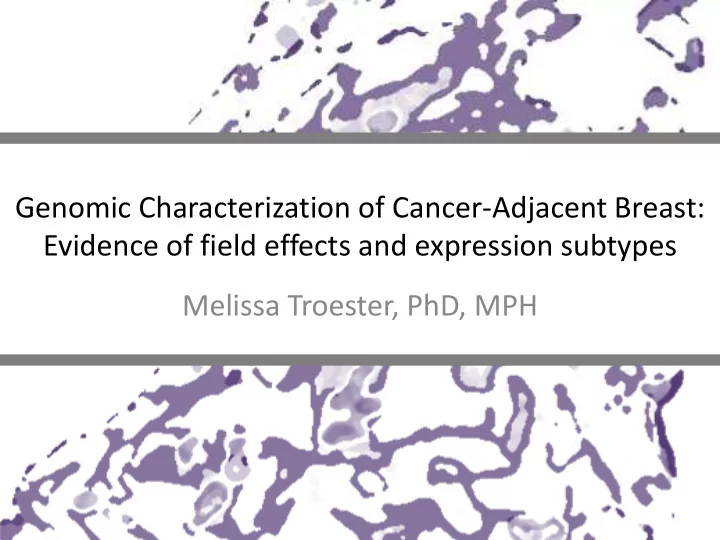

Genomic Characterization of Cancer-Adjacent Breast: Evidence of field effects and expression subtypes Melissa Troester, PhD, MPH
What Predicts Breast Cancer Recurrence? • Recurrence rates are higher for breast conserving therapy. • Local recurrence commonly occurs in the lumpectomy bed. • Local recurrence rates are higher among basal- Veronesi et al. (2002) NEJM, 347(16): 1227. like breast cancers.
Field carcinogenic events patch field cancer • Slaughter et al . (1953) observed abnormal tissue surrounding oral squamous cell carcinoma – Field cancerization explains the development of multiple primaries and local recurrences.
How does cancer-adjacent tissue respond to tumor? cancer-adjacent reduction mammoplasty • Response to wounding • Stress response • Immune response • Angiogenesis • Extracellular matrix • Chemotaxis Troester et al. (2009) Clin Cancer Res
Double Normal Breast Committee Chair: Melissa Troester, UNC RNA and DNA from 40 triplets: Copy Number blood <- normal breast -> tumor Exome Seq Alterations D. Koboldt, L. Ding, WashU A. Cherniack, Broad 40+ tumor-normal pairs Methylation normal -> tumor H. Shen, S. Mahurkar, P. Laird, USC RNAseq, microRNASeq microarray G. Robertson, BCCA M. Troester, K. Hoadley, M. D’Arcy, UNC
Double Normal Breast Committee Chair: Melissa Troester, UNC Copy Number Exome Seq Q1. Detectable field effects? Alterations D. Koboldt, L. Ding, WashU A. Cherniack, Broad Q2. Detectable tumor cells? Methylation H. Shen, S. Mahurkar, P. Laird, USC RNAseq, microRNASeq microarray G. Robertson, BCCA M. Troester, K. Hoadley, M. D’Arcy, UNC
Tumor-like copy number alterations Chromosome 8 Normal Tumor MYC Chromosome 17 Normal Tumor Erbb2 Focal peak in chromosome 10 is also seen in normal. Courtesy of Andy Cherniack
Tumor-like copy number alterations Basal-like LumB LumA 7% with ‘field effect’ OR tumor contamination
10 cases (25%) had strong evidence of field effect (many mutations with VAF >=2% in the adjacent normal). Courtesy of Dan Koboldt/Li Ding
Tumor-like mutations Basal-like LumB LumA CN 7% with ‘field effect’ OR tumor contamination 25% with ‘field effect’ OR tumor contamination
HM27 21 Tumors 21 Adjacent Normals Exp 1000 probe s with highest positive and negative tumor-normal differences Str Epi Inactive Active Expression signature (Exp) Courtesy of Swapna Mahurkar PathAveStroma (Str): 0 - 100 PathAveEpi (Epi): 0 - 15
HM450 22 Tumors 22 Adjacent Normals Exp Str 1000 probe s with highest positive and negative tumor-normal differences Epi Expression signature (Exp) Active Inactive PathAveStroma (Str): 0 - 100 Courtesy of Swapna Mahurkar PathAveEpi (Epi): 0 - 15
Tumor-like methylation patterns Basal-like LumB LumA CN Exome-Seq 7% with ‘field effect’ OR tumor contamination 25% with ‘field effect’ OR tumor contamination 7- 10% with ‘field effect’ OR tumor contamination
Double Normal Breast Committee Chair: Melissa Troester, UNC Copy Number Exome Seq Q1. Detectable field effects? Alterations D. Koboldt, L. Ding, WashU A. Cherniack, Broad Q2. Detectable tumor cells? Methylation H. Shen, S. Mahurkar, P. Laird, USC RNAseq, microRNASeq microarray G. Robertson, BCCA M. Troester, K. Hoadley, M. D’Arcy, UNC
DNA data types: Comparison & Validation A ‘positive control’ – all three DNA platforms detected the sample with tumor contamination
Histopathologic Assessment Melissa Troester, UNC Rupninder Sandhu, UNC Andy Beck, Harvard Nicole Johnson, Harvard Kim Allison, U of Wash SCORING: Pathology (tumor, benign) Immune infiltrations Percent Composition: e.g. 30% Stroma 63% Adipose 7% Epithelium
Methylation Reflecting Composition • Epithelial Content on HM450 platform (qvalue<0.05). – 13000 probes were positively correlated – 12500 probes were negatively correlated • Stromal Content on HM450 platform (qvalue<0.05): – 5700 probes were positively correlated – 2300 probes were negatively correlated • Correlation composition and DNA methylation on 27k was weak. This needs further investigation.
Double Normal Breast Committee Chair: Melissa Troester, UNC Q1. Detectable field effects? Copy Number Exome Seq Normal vs. blood Alterations D. Koboldt, L. Ding, WashU A. Cherniack, Broad Normal vs. tumor Methylation H. Shen, S. Mahurkar, P. Laird, USC RNAseq, microRNASeq microarray G. Robertson, BCCA M. Troester, K. Hoadley, M. D’Arcy, UNC
Double Normal Breast Committee Chair: Melissa Troester, UNC Copy Number Exome Seq Alterations D. Koboldt, L. Ding, WashU A. Cherniack, Broad Methylation H. Shen, S. Mahurkar, P. Laird, USC RNAseq, Q2. Detectable tumor cells? microRNASeq microarray G. Robertson, BCCA M. Troester, K. Hoadley, M. Q3. Other heterogeneity? D’Arcy, UNC
Two Subtypes of Cancer-Adjacent Tissue Active Inactive increased cell movement inflammation fibrosis chemotaxis decreased cell adhesion differentiation cell-cell contact Roman-Perez et al. (2012) Breast Cancer Res
Cancer-Adjacent Subtype vs. Tumor Subtype Inactive Active ER status Tumor subtype Active microenvironment occurs in all tumor subtypes Roman-Perez et al. (2012) Breast Cancer Res
Active Microenvironment Predicts Survival Roman-Perez et al. (2012) Breast Cancer Res
mRNA and microRNA subtypes • RNA expression clusters – Two main clusters by microRNA-seq – Two main clusters by RNA-seq • RNA and miRNA concordance • Tumor characteristics (ER status, intrinsic subtype, etc.) not strongly associated with main clusters • ‘Probable contamination’ samples not readily detected. Courtesy of Gordon Robertson
RNA Expression Subtype vs. Composition % Epithelium % Stroma % Adipose Active Inactive Active Inactive Active Inactive
Conclusions & Future Directions • DNA shows field effects/tumor contamination RNA identifies expression subtypes • Distinguishing field effects vs. tumor cells
Acknowledgments UNC: Melissa Troester, Katie Hoadley , Monica D’Arcy, Rupan Sandhu, Chuck Perou Buck Institute: Christopher Benz, Christina Yau Broad: Andrew Cherniack Wash U: Dan Koboldt, Li Ding BCGSC: Gordon Robertson USC: Peter Laird, Swapna Mahurkar, Hui Shen Harvard: Andy Beck, Nicole Johnson U of Washington: Kim Allison NCI: Margi Sheth, Jay Bowen, Kenna Shaw
Recommend
More recommend